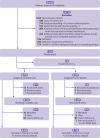Surgical fixation with K-wires versus casting in adults with fracture of distal radius: DRAFFT2 multicentre randomised clinical trial
- PMID: 35045969
- PMCID: PMC8767805
- DOI: 10.1136/bmj-2021-068041
Surgical fixation with K-wires versus casting in adults with fracture of distal radius: DRAFFT2 multicentre randomised clinical trial
Erratum in
-
Surgical fixation with K-wires versus casting in adults with fracture of distal radius: DRAFFT2 multicentre randomised clinical trial.BMJ. 2022 Feb 17;376:o423. doi: 10.1136/bmj.o423. BMJ. 2022. PMID: 35177404 Free PMC article. No abstract available.
-
Surgical fixation with K-wires versus casting in adults with fracture of distal radius: DRAFFT2 multicentre randomised clinical trial.BMJ. 2022 Mar 4;376:o580. doi: 10.1136/bmj.o580. BMJ. 2022. PMID: 35246413 Free PMC article. No abstract available.
Abstract
Objective: To assess wrist function, quality of life, and complications in adult patients with a dorsally displaced fracture of the distal radius, treated with either a moulded cast or surgical fixation with K-wires.
Design: Multicentre randomised clinical superiority trial, SETTING: 36 hospitals in the UK National Health Service (NHS).
Participants: 500 adults aged 16 or over with a dorsally displaced fracture of the distal radius, randomised after manipulation of their fracture (255 to moulded cast; 245 to surgical fixation).
Interventions: Manipulation and moulded cast was compared with manipulation and surgical fixation with K-wires plus cast. Details of the application of the cast and the insertion of the K-wires were at the discretion of the treating surgeon, according to their normal clinical practice.
Main outcome measures: The primary outcome measure was the Patient Rated Wrist Evaluation (PRWE) score at 12 months (five questions about pain and 10 about function and disability; overall score out of 100 (best score=0 and worst score=100)). Secondary outcomes were PRWE score at three and six months, quality of life, and complications, including the need for surgery due to loss of fracture position in the first six weeks.
Results: The mean age of participants was 60 years and 417 (83%) were women; 395 (79%) completed follow-up. No statistically significant difference in the PRWE score was seen at 12 months (cast group (n=200), mean 21.2 (SD 23.1); K-wire group (n=195), mean 20.7 (22.3); adjusted mean difference -0.34 (95% confidence interval -4.33 to 3.66), P=0.87). No difference was seen at earlier time points. In the cast group, 33 (13%) of participants needed surgical fixation for loss of fracture position in the first six weeks compared with one revision surgery in the K-wire group (odds ratio 0.02, 95% confidence interval 0.001 to 0.10).
Conclusions: Among patients with a dorsally displaced distal radius fracture that needed manipulation, surgical fixation with K-wires did not improve patients' wrist function at 12 months compared with a cast.
Trial registration: ISRCTN registry ISRCTN11980540.
© Author(s) (or their employer(s)) 2019. Re-use permitted under CC BY. No commercial re-use. See rights and permissions. Published by BMJ.
Conflict of interest statement
Competing interests: All authors have completed the ICMJE uniform disclosure form at www.icmje.org/disclosure-of-interest/ and declare: support from the UK NIHR HTA Programme for the submitted work; MLC is an NIHR senior investigator and a member of the General Board for the NIHR HTA funding stream; SEL was on the HTA Additional Capacity Funding Board, HTA End of Life Care and Add-on Studies Board, HTA Prioritisation Group Board, HTA Trauma Board, and HTA MNCH Methods Group (2013-15) and was deputy chair of HTA Primary Care Themed Call Board (2013-14) and chair of the NIHR CTU Standing Advisory Committee (2012-16); JAC was a member of the HTA Efficient Study Designs Board (2014, 2015-16) and of the HTA End of Life Care and Add-on Studies Board (2015-16); JD receives grants from the NIHR HTA programmes (11/36/37 and 15/102/04); no other relationships or activities that could appear to have influenced the submitted work.
References
Publication types
MeSH terms
LinkOut - more resources
Full Text Sources
Medical
Miscellaneous

